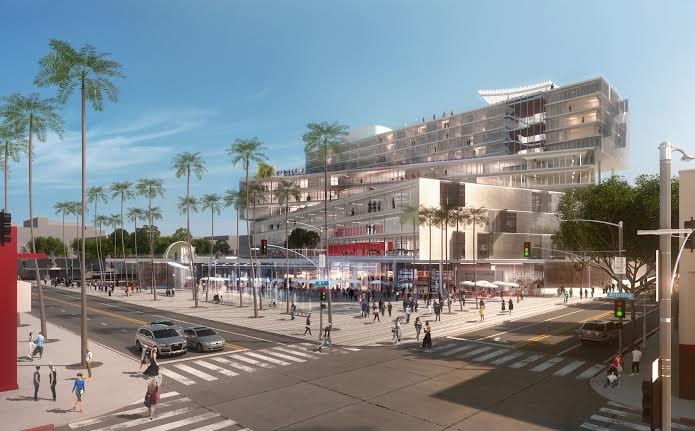
It has become a common scene in Santa Monica. A standing-room only crowd packs into a conference room at the library. Anti-development activists jeer their neighbors who speak out in favor of plans for one project or another while the moderator struggles to keep the meeting from descending into chaos.
At these meetings, it’s not long before the conversation turns from the merits of the proposed project to a competition over who truly speaks for the “Residents,” of which there are about 91,000 in Santa Monica.
The underlying assumption, of course, being that those residents’ voices that support the project are somehow inauthentic. (Gary Kavanagh wrote an in depth piece on this rhetorical strategy in February.)

Monday night’s meeting about the 12-story mixed-use Plaza at Santa Monica, a Rem Koolhaas-designed building slated to replace two squat bank buildings and a surface parking lot on a 2.5-acre City-owned lot a block east of the 3rd Street Promenade, almost followed the same pattern. Except that this time, the anti-development crowd wasn’t speaking with the dominant voice in the room.
Amidst claims by the projects’ detractors that the “Residents” were united in opposition to the design, many community members – some newcomers, some life-long residents – spoke out in favor of seeing the new project built.
“I honestly get a little upset when some people claim to speak for all residents,” one speaker prefaced his question about the project. He said that he lived a few blocks from the proposed project before asking what hours the 43,650 square feet of public open space proposed for the site would be open for programming.
Nothing past 10 p.m. and nothing earlier than 7 a.m. was the developer team’s response.
As proposed, the 12-story building would include a 225-room boutique union hotel, 48 units of affordable housing, 40,000 square feet of neighborhood-serving retail, a bike center at street level, 172,000 square feet of office space, and 1,220 underground parking spaces. The plans include room for a children’s museum. The parcel is also a possible location for a bikeshare station.
And all of that would be three blocks from the future Expo light rail station at 5th Street and Colorado Avenue.
When one young lady, who said she grew up in Santa Monica, spoke in favor of the project, she immediately drew a snide comment from someone in the audience who she must be getting paid to say this.
About 20 residents who are members of the regional hospitality workers’ union, UNITE HERE Local 11, also turned out to support the project, which would add between 150 and 200 new high-paying hotel jobs and an affordable housing component managed by the city’s leading nonprofit affordable housing developer, Community Corporation of Santa Monica.
“Will there be a place for young professionals to grab a drink?” asked Melanie Luthern, an organizer with UNITE HERE and recent transplant to Santa Monica. The answer was yes, since the hotel will have a lobby bar open to the public.
Some of the anti-development activists spoke up, demanding that the lot be turned into a park, though they were fuzzy on the details of how to finance such a conversion. Or, they demanded that the building be no higher than 84 feet, even though such a change would mean a reduction in the amount of open space and number of affordable housing units.
One person opposed the project because she claimed that the drought meant Santa Monica’s water supply simply could not support any more people, though she did not mention if she supported a park at the location.
One speaker, self-described peace activist Jerry Rubin, was heckled when he decided to chime in about how much he liked about the project.
“What about the trees, Jerry!?” one heckler shouted, presumably because Rubin is known as a fierce advocate for conservation of the city’s urban forest, though Santa Monica Next was unable to ascertain the exact meaning of the heckler’s comments, since the redesign would actually add more green space to the lot.
Despite the jeers while speaking, Rubin received sustained applause from the members of the audience who hadn’t heckled him after he finished his comments.
The moderator succeed, mostly, to steer the conversation into calmer waters, but proponents of the project did continually find themselves having to stand up to jeers. After the meeting, the anti-development activists took to social media to talk about how none of the residents’ voices are being heard.
Here are a couple highlights from the online discussion:
Despite claims that developers have completely ignored residents’ concerns on this project, it seemed pretty clear from Monday’s meeting that there were plenty of residents out there who are quite happy with this project, so much so that they were willing to put up with verbal abuse to make sure that it happens.



